 You are here: Home > All About Hand Dyeing > FAQ > General Dyeing Questions > How to Tie Dye with Kool-Aid®
You are here: Home > All About Hand Dyeing > FAQ > General Dyeing Questions > How to Tie Dye with Kool-Aid®
Tie Dye with Kool-Aid
The idea of dyeing with food coloring, either in the tiny
bottles mostly used for egg dyeing, or in artificially
colored drink mix, is very appealing for one very
significant reason: these dyes are safe for use even by children
who can't be trusted not to eat their tie-dye
projects. However, there is one rule you must remember:
Do not try to dye cotton with food coloring!
Food coloring on cotton is a stain, not a dye, and will not
last. You can't make it permanent. If you want to dye
cotton, use fiber
reactive dye with the how to dye cotton recipe,
and don't let your kids eat the dye.
Artificially colored drink mixes can be used for dyeing wool
and other protein (animal) fibers, and frequently also
nylon. (Some nylon garments are treated with Teflon or other
coatings, which prevent dyeing.) They
do not attach permanently on cotton or synthetics other than
nylon, unless you
never, ever wash the item in question.
The answer, then, is to use wool, silk, or nylon. You must
also apply heat.
Acid Dyes
Food coloring belongs to the class of dyes known as acid dye. Its
attachments to protein fibers, and also to nylon (but no
other synthetic), are in the form of ionic and hydrogen bonds. The
acid required for the dye reaction is provided, quite
conveniently, in the form of citric acid for tartness in the
drink mix flavoring. If you use plain food coloring drops,
you'll need to pre-soak your fabric or yarn in some plain
white vinegar, instead.
No sugar, please!
The last thing you want is a gummy mess, but that's what
you'll get if you cook sweetened drink mix onto your
project. Be sure to use unsweetened drink mixes only!
(Artificial sweetening is probably just fine, but
unsweetened drink mix, to which you are supposed to add your
own sugar when mixing drinks, is ideal.)
Alternatively, you can use drops of concentrated liquid food
coloring, or almost any form of packaged Easter egg dye.
What colors are available?
Many colorings that are legal for use in foods in one
country are banned in another; conversely, those dyes allowed
in the latter country may be banned in the former. In the
US, the list of legal synthetic food dyes is short:
| dye name | F D & C food
dye
number | Colour Index
number | E or INS
number* | frequently associated flavors
(check ingredients lists) |
|---|
| allura red | red dye #40 | 16035 | E129 | cherry, strawberry |
| brilliant blue FCF | blue #1 | 42090 | E133 | blue raspberry, blue moon berry |
| sunset yellow FCF | yellow #6 | 15985 | E110 | mango |
| indigotine | blue #2 | 73015 | E132 | |
| fast green FCF | green
#3 | 42053 | INS 143 | |
| erythrosine | red #3 | 45430 | E127 | |
| tartrazine | yellow #5 | 19140 | E102 | lemonade |
(*E numbers are European food additive numbers, being replaced by INS numbers, which
are international but are largely the same as E numbers.)
All other food colorings in the US, aside from a few natural
dyes such as annatto, turmeric (spice), beet extract, and
carmine (red insects, used to color yogurt and other foods),
are composed of different combinations of the above.
Project
This project is designed for use with children; it is not
optimized for art use, as food coloring is not the most
lightfast of dyes (that is, you may find that it fades badly
after a year or so).
- What to dye.
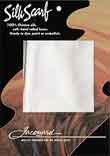
 First you need to select an appropriate dyeable - wool yarn,
nylon fabric, silk scarf. You can buy silk scarves for two to eight dollars each, depending on size, by mail order from companies such as
Rupert Gibbon & Spider and Dharma Trading Company; see Sources for Dyeing
Supplies, or see MisterArt's
Jacquard white silk scarf.) Do not choose anything containing a cellulose
fiber such as cotton, rayon, or linen, nor any synthetics
other than nylon, such as polyester or acetate.
First you need to select an appropriate dyeable - wool yarn,
nylon fabric, silk scarf. You can buy silk scarves for two to eight dollars each, depending on size, by mail order from companies such as
Rupert Gibbon & Spider and Dharma Trading Company; see Sources for Dyeing
Supplies, or see MisterArt's
Jacquard white silk scarf.) Do not choose anything containing a cellulose
fiber such as cotton, rayon, or linen, nor any synthetics
other than nylon, such as polyester or acetate.
- Choose your dyes.
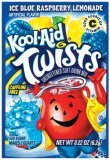 Select your favorite colors of unsweetened artificially
colored drink mix. Plan on about one packet of drink mix per
ounce of fiber, if you like intense colors. (Blue drink mixes are becoming difficult to find in some areas, but can still be purchased online; see, for example, Twist Blue Mountain Berry Kool-Aid at Amazon.)
Select your favorite colors of unsweetened artificially
colored drink mix. Plan on about one packet of drink mix per
ounce of fiber, if you like intense colors. (Blue drink mixes are becoming difficult to find in some areas, but can still be purchased online; see, for example, Twist Blue Mountain Berry Kool-Aid at Amazon.)
- Pre-soak your fiber.
If you are using a drink mix that contains an acid, such as
citric or malic acid, for tartness, dampen your fabric or
yarn with water, or you can use water with some added
vinegar, just to be sure. If you are using pure food coloring or egg
dye, dampen with plain white vinegar, instead, mixed
half-and-half with water. Squeeze out
excess water and vinegar, leaving your fiber wet.
- Tie. (Optional.) For a true tie-dye project,
you may use rubber bands to tighten the fabric where you
want it to remain white. Many people prefer dyeing with no
ties at all, however. Since you are applying your colors
directly, you can get quite nice designs with no need for
the ties.
- Select a dish. Here's where this
form of dyeing becomes especially convenient. There is no
need to devote a dish solely to dye use, since these dyes
are food-safe; you can use any kitchen container that is
suitable for microwaving. Choose one as wide as will fit in
your microwave oven conveniently. Arrange your damp material in
the dish.
- Add dye. Sprinkle on your drink
mix or food coloring in a pleasing rainbow pattern. You can
use the drink mix either dry (it will dissolve on the wet
fabric) or dissolved in a very small amount of water. Remember
that you don't want to put opposite colors next to each
other, such as red next to green, orange next to blue, or
yellow next to purple, as you will end up with a muddy
brown if you do. Place colors in rainbow order. After
covering the top layer, use gloved hands, or tongs or other
kitchen implements, to turn the fabric or yarn over in the
dish, to do the same to the other side(s).
- Cover the dish. Use a lid, plate
or microwavable plastic wrap to seal the dish tightly. This
will trap steam to ensure that all parts of the fabric get
treated, and prevent one region from drying out and burning
before the rest is even hot.
- Heat in the microwave. (Obviously,
this part is to be done only by adults or teens, though
young children can do the dye application.) Watching
closely the entire time, heat for anywhere from fifteen
seconds to a minute or two, until
the material is hot. You will see the steam start to inflate
the plastic wrap, and condense inside the plastic wrap; that
is when you must press "STOP". Let it rest for a minute, then heat
again. Alternatively, heat for five minutes on reduced
power (20%), but be sure to watch constantly
. The danger is that
overheated fiber can actually catch on fire in the
microwave, if it is allowed to get too dry. It must get
quite hot in order for the dye to attach permanently to the
fiber, however. If you do not have access to a microwave
oven, you can use a vegetable steamer and steam for half an
hour, instead.
- Allow to cool. The time spent
gradually cooling will allow more bonding to occur.
- Rinse. Using cool water, rinse
until the water that runs off no longer contains dye.
- Laundering. When laundering
becomes necessary, wash in cool water on the delicate
cycle, or hand wash; be sure to follow any care instructions
for wool.
Safety warnings
How can there be any safety hazards, with food-safe dye?
First, never breathe the drink mix powder. Breathing dye is
unhealthy; breathing almost any powder is unhealthy.
Second, don't let your children learn, from this food-safe
experiment, that it is okay to taste your dyes! You may
think that this is silly, but my young son developed the
appalling idea, from our early chemistry experiments
together, such as growing crystals from salt and sugar, that it was
okay to taste chemicals. Fortunately I was watching closely
the time he decided to taste a non-food-safe experiment!
 See
answers to more questions about dyes and dyeing
See
answers to more questions about dyes and dyeing
Kool-Aid® is a registered trademark of Kraft Foods Holdings, Inc.
Page created: August 11, 2002
Last updated: May 17, 2003
Downloaded: Sunday, December 14, 2025

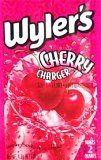
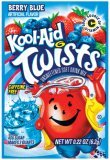
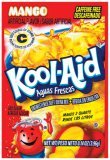

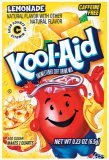

 Select your favorite colors of unsweetened artificially
colored drink mix. Plan on about one packet of drink mix per
ounce of fiber, if you like intense colors. (Blue drink mixes are becoming difficult to find in some areas, but can still be purchased online; see, for example, Twist Blue Mountain Berry Kool-Aid at Amazon.)
Select your favorite colors of unsweetened artificially
colored drink mix. Plan on about one packet of drink mix per
ounce of fiber, if you like intense colors. (Blue drink mixes are becoming difficult to find in some areas, but can still be purchased online; see, for example, Twist Blue Mountain Berry Kool-Aid at Amazon.)
 See
answers to more questions about dyes and dyeing
See
answers to more questions about dyes and dyeing